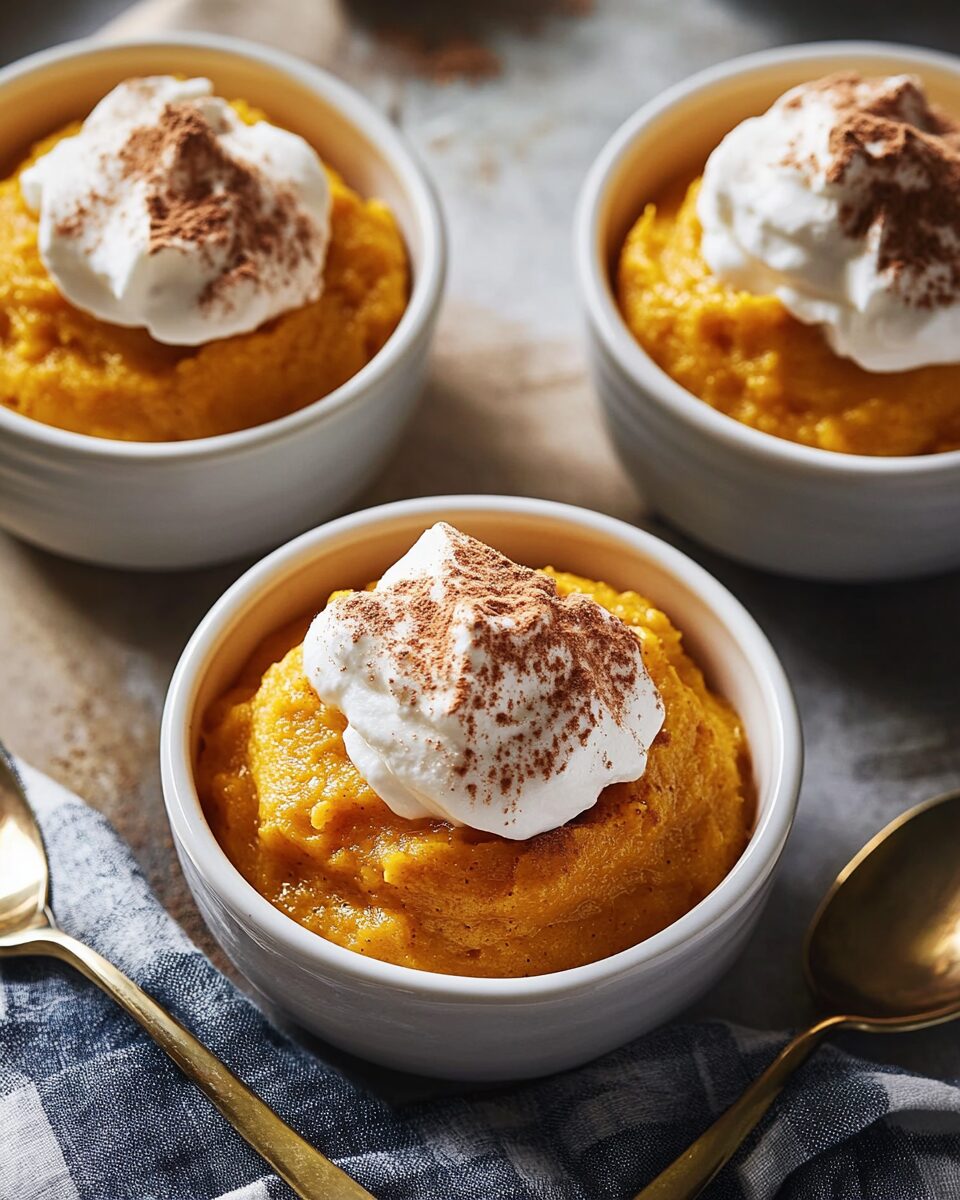The warmth of baked sweet potatoes, spiced just right with cinnamon and nutmeg, makes this Sweet Potato Pudding a true Southern classic. Its velvety texture and hint of vanilla make every bite rich and comforting.
Whether you’re prepping for the holidays or simply want a timeless dessert with soul, this dish is a go-to. It’s budget-friendly, crowd-pleasing, and can be dressed up with whipped cream or nuts, or enjoyed plain and warm from the oven. Serve it at Thanksgiving, family gatherings, or any time your soul craves something sweet and nostalgic.
Full recipe:
Ingredients:
-
2 large sweet potatoes (about 1½ lbs), peeled and cut into chunks
-
¾ cup granulated sugar
-
½ cup evaporated milk
-
¼ cup unsalted butter, melted
-
2 large eggs
-
1 tsp vanilla extract
-
½ tsp ground cinnamon
-
¼ tsp ground nutmeg
-
¼ tsp salt
-
Optional: whipped cream or chopped pecans for garnish
Directions:
-
Preheat oven to 350°F (175°C). Grease a medium-sized baking dish with butter or nonstick spray.
-
Boil sweet potato chunks in a large pot of water until tender, about 20 minutes. Drain and let cool slightly.
-
Transfer sweet potatoes to a large bowl and mash until smooth.
-
Add sugar, evaporated milk, melted butter, eggs, vanilla extract, cinnamon, nutmeg, and salt. Whisk until well combined and smooth.
-
Pour the mixture into the prepared baking dish and smooth the top with a spatula.
-
Bake for 40-45 minutes, or until the center is set and the top is golden brown.
-
Let cool slightly before serving. Top with whipped cream or chopped pecans, if desired.
Prep Time: 15 minutes | Cooking Time: 45 minutes | Total Time: 1 hour
Kcal: 290 kcal | Servings: 6 servings
Origins and Cultural Significance
The history of Sweet Potato Pudding traces back to the Southern United States, particularly within African American communities. Sweet potatoes themselves have a long-standing connection to African cuisine. When enslaved Africans were brought to the Americas, they carried culinary traditions with them that adapted to local ingredients—sweet potatoes being one of the most accessible.
Sweet Potato Pudding is a natural evolution of those traditions. It reflects resourcefulness, creativity, and a reverence for natural, whole ingredients. The pudding became a staple at special occasions—holidays like Thanksgiving and Christmas—when families gathered and meals were crafted with love and intention.
Even today, it’s more than just a dessert; it’s a dish that carries legacy. For many, it’s a link to past generations, a reminder of home, and a symbol of Southern hospitality and heritage.
Flavor Profile and Texture
This pudding is known for its earthy sweetness, thanks to the naturally sugary flavor of sweet potatoes. The addition of warm spices like cinnamon and nutmeg adds complexity and depth, while vanilla often enhances the aroma and flavor with a subtle, floral sweetness.
In terms of texture, Sweet Potato Pudding is rich, smooth, and custard-like. The eggs and milk provide structure while maintaining creaminess. It’s not as firm as pie, nor as runny as a stovetop pudding—it’s somewhere in between, making it unique in the world of desserts.
When baked just right, the top develops a gentle golden-brown crust, while the inside remains soft and velvety. It’s comforting, satisfying, and flavorful without being overly sweet.
Why People Love Sweet Potato Pudding
There’s something universally appealing about Sweet Potato Pudding. It’s a dessert that feels like a warm hug—simple, satisfying, and heartwarming. Here are a few reasons why this dish is cherished:
-
Comfort Food Appeal: The warm spices, soft texture, and naturally sweet flavor make it a go-to for emotional comfort and cozy meals.
-
Nostalgia: Many people associate this dessert with their childhood, family gatherings, and holidays.
-
Healthier Alternative: Compared to some heavy, sugar-laden desserts, Sweet Potato Pudding offers nutritional value—fiber, vitamin A, potassium, and antioxidants from the sweet potatoes.
-
Versatility: It’s easy to customize. Some add coconut milk, raisins, or even a dash of rum for extra depth.
-
Ease of Preparation: The recipe requires minimal ingredients and is very forgiving, making it accessible to both beginner and seasoned home cooks.
Modern Twists on a Traditional Dessert
While traditional recipes are always appreciated, modern cooks have found creative ways to adapt Sweet Potato Pudding for different tastes and dietary needs:
-
Vegan Sweet Potato Pudding: Substituting plant-based milk and flax eggs makes this dish suitable for vegans without sacrificing flavor or texture.
-
Mini Puddings: Baking the mixture in ramekins or muffin tins offers single-serving portions that are perfect for dinner parties or portion control.
-
Spiked Versions: Adding a splash of bourbon or dark rum introduces a sophisticated, adult twist to the traditional flavor profile.
-
Toppings Galore: Beyond whipped cream, people are experimenting with marshmallow fluff, candied ginger, caramel drizzle, or spiced nuts.
These variations keep the dish relevant in modern kitchens while still honoring its roots.
Pairings and Serving Suggestions
Sweet Potato Pudding is quite versatile when it comes to serving. It can be enjoyed hot, warm, or even chilled. Some common and creative ways to serve it include:
-
With Whipped Cream: A classic pairing that adds lightness and contrast to the dense pudding.
-
Drizzled with Maple Syrup: For an extra hit of sweetness and a touch of autumnal flavor.
-
Sprinkled with Toasted Pecans or Walnuts: Adds crunch and nutty richness.
-
With Vanilla Ice Cream: The warmth of the pudding against cold ice cream is irresistible.
-
As a Breakfast Option: In some households, leftovers are served for breakfast alongside coffee or tea—especially during the holidays.
Whether it’s a centerpiece dessert or a late-night indulgence, this pudding adapts beautifully to any occasion.
Nutritional Considerations
Despite being a dessert, Sweet Potato Pudding brings some nutritional benefits to the table. Sweet potatoes are nutrient-dense—rich in beta-carotene (which converts to vitamin A), fiber, and antioxidants. When made with moderate amounts of sugar and fat, it can be a relatively wholesome treat compared to other heavy desserts.
Of course, portion size and add-ons like whipped cream or sugary toppings will affect the overall healthiness, but it’s possible to enjoy this dessert guilt-free with a few thoughtful tweaks.
Seasonal and Holiday Popularity
Although this dish can technically be enjoyed year-round, it’s particularly popular during fall and winter months. The warm spices and hearty texture align perfectly with colder weather and holiday menus.
Thanksgiving, Christmas, and other winter celebrations often feature Sweet Potato Pudding as a dessert staple. It’s an alternative to pumpkin pie and a must-have for those who grew up with it as a part of their family traditions.
Many cooks prepare large trays of it for potlucks, church dinners, or family reunions, where it’s guaranteed to disappear quickly.
Tips for Perfecting Sweet Potato Pudding
To elevate your Sweet Potato Pudding, here are some pro tips from experienced home cooks and chefs:
-
Use Roasted Sweet Potatoes: Roasting instead of boiling enhances the natural sweetness and prevents wateriness.
-
Don’t Overmix: Mixing the ingredients until just combined ensures a smooth, tender pudding without a dense or rubbery texture.
-
Spice Balance: Be mindful of spice ratios—too much nutmeg can overpower the dish.
-
Allow It to Set: Let the pudding cool for at least 15 minutes before serving. This helps it firm up slightly and enhances flavor.
Conclusion
Sweet Potato Pudding is more than a simple dessert—it’s a taste of tradition, a hug in a bowl, and a reflection of cultural resilience and creativity. Rooted in Southern cooking and African American heritage, this humble dish continues to win hearts across generations and regions.
Its luscious texture, soulful flavor, and nourishing base make it a standout addition to any dessert table. Whether you’re making it for the first time or reliving cherished memories, Sweet Potato Pudding is sure to leave a lasting impression.
From holidays to weeknights, from tradition to innovation, this dessert proves that simplicity and depth can coexist beautifully on a plate. It’s the kind of recipe that tells a story—with every bite.






